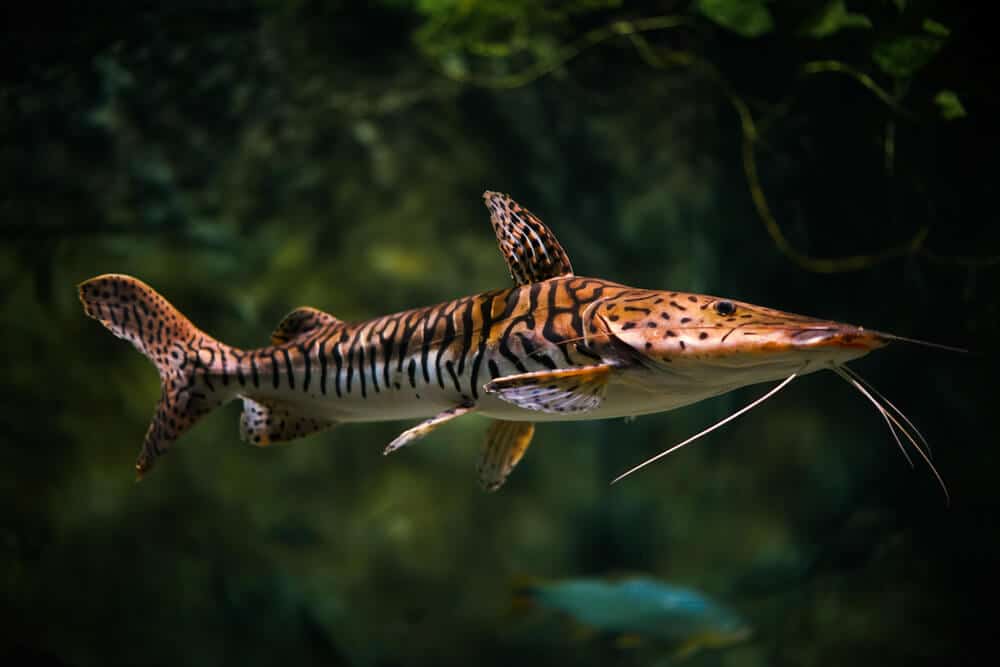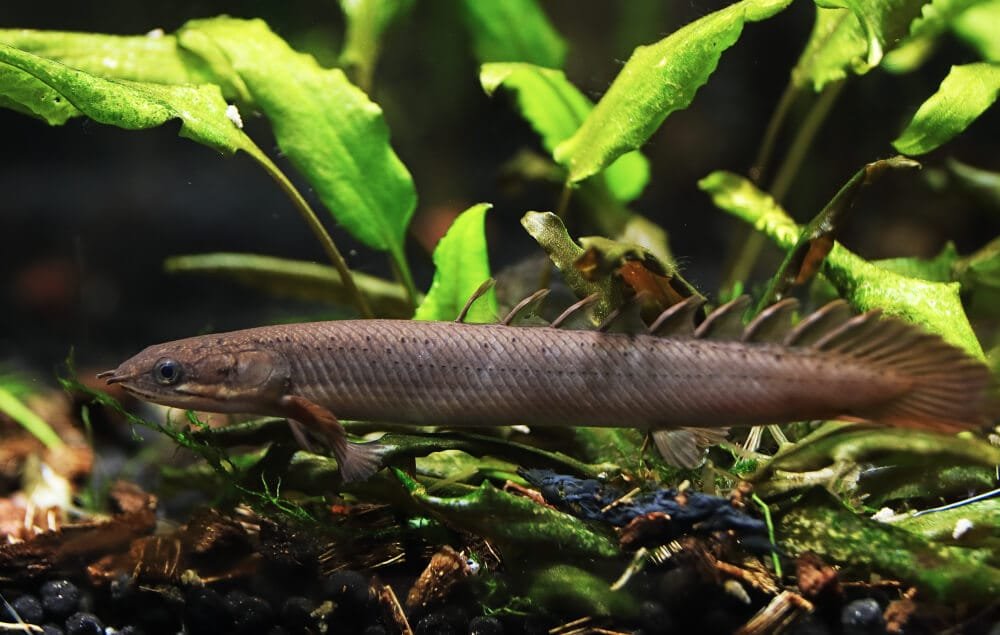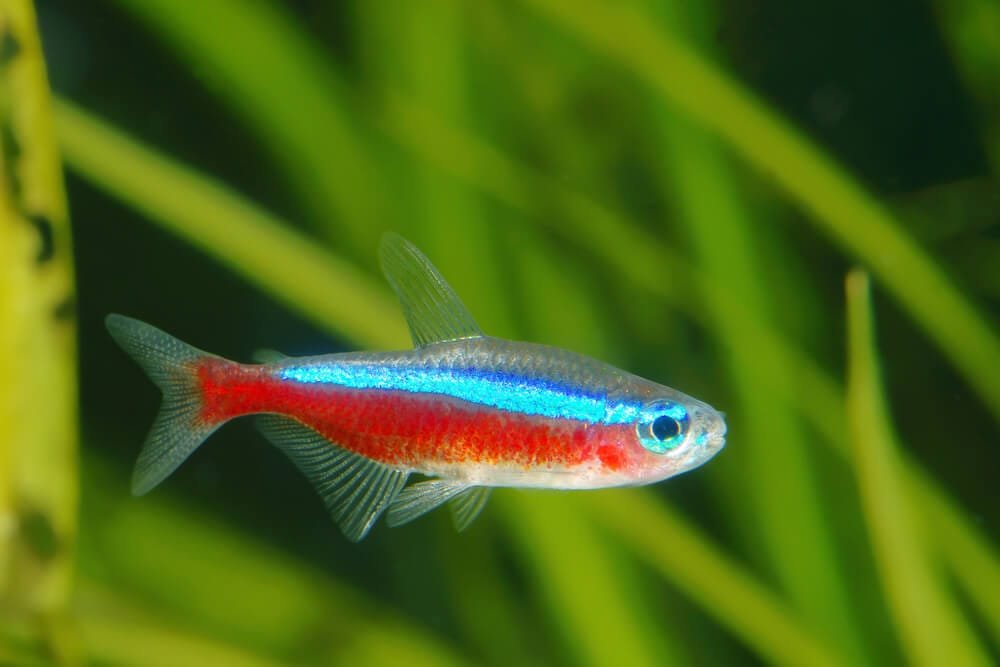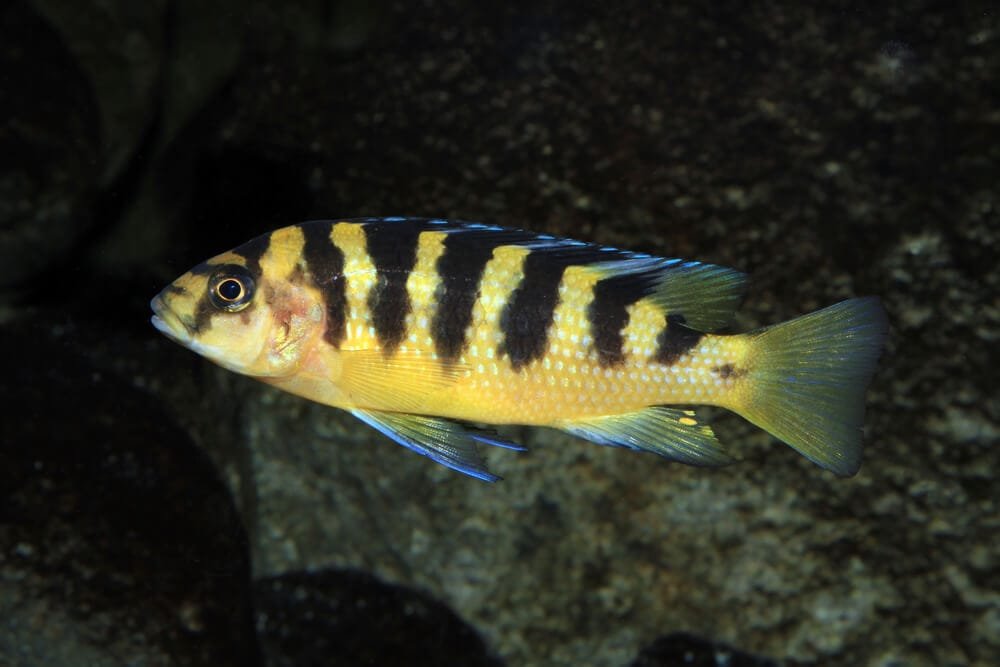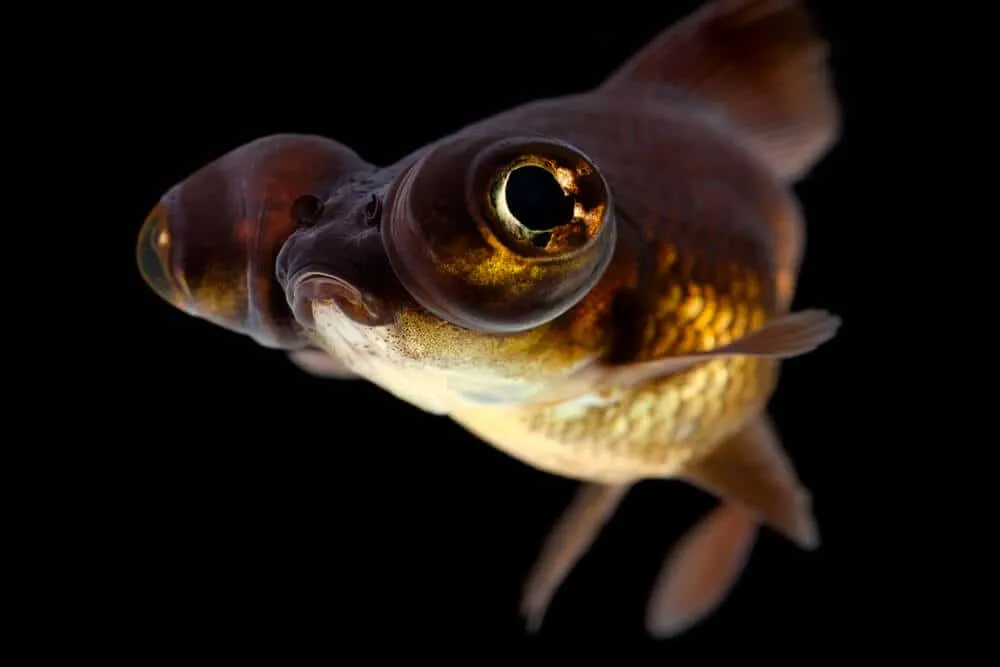Species Overview
COMMON NAMES: Barred Sorubium, Shovelnose Tiger Catfish
SCIENTIFIC NAMES: Pseudoplatystoma Fasciatum
ADULT SIZES: 2.5- 4 ft.
LIFE EXPECTANCY: 18-25 Years
Characteristics
Family: Pimelodidae
Origin: Brazil, The Amazon River Basin, Peru, Argentina, and Venezuela
Social: Loner/ can be aggressive
Tank Level: Mid to bottom
Minimum Tank Size: 180 gallons
Diet: Carnivore
Breeding: Egg layer
Care: Medium level
pH: 6.5 – 7.8
Hardness: KH 6-20,
Temperature: 75-82° F
The Tiger Shovelnose catfish is a unique freshwater fish gaining popularity among aquarists quickly. This large and exceptional fish will bring great value to your aquarium.
These catfish love to swim at the deepest levels of the main channels of significant rivers where they live. You can also find some species in some freshwater habitats, forests, and lakes. Unfortunately, the Tiger shovelnose catfish’s habitat and population are under threat from overfishing and the building of dams.
Their aggressive behavior and tendency to pick on other weaker fish make it unfavorable for beginners to keep. Some more profound knowledge about keeping this fish is encouraged.
If you are a beginner, we advise you to prepare yourself with adequate knowledge before embarking on this venture. This article will give you every detail about owning this fish. Read on to learn more and learn about their care and breeding, diet, diseases, and more.
Overview And Special Features
Tiger shovelnose catfish is a large fish whose origin is South America. It is also known as Pseudoplatystoma fasciatum, barred sorubim, or barred catfish. With other known species, it belongs to the family Pimelodidae. It is a famous and vital fish to pet lovers.
The fish has long whiskers over the mouth and go by the name Surubi in its native home. The fish lives in freshwater and has a sturdy body, making it essential for food. Anglers and other invasive species companions have recently jeopardized this fish’s population.
If you provide this fish with plenty of space to swim, you will be amazed at how large it can grow. Keeping this fish in a large tank will be ideal due to its size and active nature. Ensure that you tightly secure your tank so that the fish does not jump and find its way out of the tank.
The minimum tank size for this fish should be 180 gallons. In addition, the tank setup provides a home with a near-natural habitat feeling. You can install rock caves, wood, and vegetation.
Other known species of the Pseudoplatystoma genus include;
- Pseudoplatystoma
- P. reticulatum
- P. metaense
- P. magdaleniatum
- P. tigrinum
- P. orinocoense
- P. fasciatum
- Pseudoplatystoma
These fish are enormous, and their bodies have prominent spots. One more feature to identify them is their long fontanel and hollow heads. The unusual color marking patterns make them unique and famous in the petting industry.
- Pseudoplatystoma reticulatum
The P. reticulatum has a name that describes its body patterns. These patterns are dark spiral bars, and they form a net-like design. These fish’s patterns differ from those of the P. orinocoense and P. fasciatum species.
- Pseudoplatystoma metaense
The fish’s greyish part of the body has a random distribution of spots. The fish also has a maximum of five dark, vertical bars on the side of its body.
- Pseudoplatystoma magdaleniatum
The P. magdaleniatum depicts dark, straight, and broad vertical bars. It has no curly or circular patterns on its nape or the rest of the body.
- Pseudoplatystoma tigrinum
P. tigrinum species depicts convolutions that spread to the other side of the body through the dorsal region. Unlike others, the sides of the fish body do not have distinct dark spots.
- Pseudoplatystoma orinocoense
This fish’s body is moderately stout. Their body has bars that run through it and connect to the dorsal region.
- Pseudoplatystoma fasciatum
The P. fasciatum species is larger than most Amazon species. It reaches an optimum length of 35inches. The fish’s body has dark and white vertical bars; a slimmer cranium than other species; spotted darker in color pelvic and dorsal fins.
Habitats
Pseudoplatystoma inhabit large river basins, floating meadows, and lakes, swimming and feeding on other fish in the deep waters. You can also find these fish in flooded forests and under vegetation, which provides them with plenty of shade, an environment they prefer. Their babies also live in flooded areas until they mature.
You may wonder how these fish swim through the cloudy and dark waters. Well, their long maxillary barbels on their mouth do the magic. These barbels also help them sense the location of their prey.
You can find these fish in the following rivers: Madeira, Suriname, Orinoco, Amazon, and several other rivers flowing into the Atlantic Ocean or the Caribbean Sea.
Tiger Shovelnose Catfish Appearance
These fish have a very appealing appearance, which makes them unique and popular among hobbyists. These fishes have robust, elongated, and slender bodies.
These fish have long-drawn-out whiskers and flat and wide mouths. Their bodies also have a silver shade with spots and dark stripes, which makes them look like a tiger. Their unique body features help them easily navigate the muddles in their habitat, searching for prey.
These fish’s anal and pectoral fins have similar patterns. The dorsal fins resemble the elegant spirals of a seashell and have an average size. Their forked caudal fins enable the fish to swim without resistance and have black spots.
Behavior And Temperament Of The Tiger Catfish
Tiger shovelnose catfish are highly energetic fish whose large bodies help keep off bullies. Sometimes though, they show aggressive behavior. They can be territorial if you keep them in a small aquarium and may intimidate other fish with their big sizes.
Despite their natural lifestyle of living and feeding in the deep waters, these fish species will explore all tank levels in captivity.
Due to their highly dynamic behavior, it is easy to monitor them. Any indication of inactivity may be a sign that the fish are ailing and need extra care. Look out for decreased motion behavior and examine what could be ailing them in good time.
And, because these fish are aggressive, you should plan accordingly before purchasing one. They will often become territorial and pick on other fish who are unable to defend themselves.
Size Of Tiger Shovelnose Catfish
These fish are massive, a unique feature among their family. Their measurements are approximately 2.5 to 3 ft. However, they grow enormously in the wild and can achieve a maximum of 4 ft.
The Tiger Shovelnose Catfish can grow significantly large and at a fast rate. If you need these fish, you must have a large tank and be ready to adequately provide for all their other needs.
Of all Tiger Shovelnose Catfish species, the Pseudoplatystoma Tigrinum is the largest. It grows up to 51 inches. These fish can live peacefully with other large fish since they only eat smaller fish.
Nothing comes in the way of their growth, whether you feed them with lots of food or otherwise. Their sizes increase at a faster rate once their reproductive organs reach maturity.
It is evident then that the tank should be huge for your fish to achieve an elongated size. The ample space helps them swim freely, allowing them to enlarge their sizes.
The Lifespan Of The Tiger Catfish
These fish live for approximately 18-25 years. The fish’s lifespan range is bound to fluctuate depending on the type of care given and hereditary factors.
In captivity, these fish may not achieve the optimum age. It would help if you did not fret about the fish water parameters since they are hardy and can adjust to various settings. However, it is wise to balance everything to keep them healthy and happy.
Caring For The Catfish
Caring for these catfish species is not a walk in the park. You will need to understand how to prepare and sustainably maintain proper care for the fish. This section will discuss tips to help you achieve your dream of petting these catfish.
Tank Size And Setup
As we have discussed, the size of these catfish is enormous. It is also evident that these fish require ample space for their comfort and happiness.
The best tank size for the catfish is 180-200 gallons for young ones and 250 gallons and above for the all-grown ones. Failure to provide the desirable tank size will only mean that you will be restricting your fish’s movement, making them feel miserable.
Comfort is the most crucial aspect of the care for these catfish. Therefore, it is up to the aquarists to ensure that the fish live a stress-free life and the total number of years they deserve.
We would rather you abstain from keeping these fish if you are not ready to provide enough space for these fish.
Water Parameters
Water Hardness: 6-20 KH
Water Temperature: 75°F to 82°F
pH Levels: 6-8
These catfish are resilient and can adjust to a variety of water standards. These freshwater aquatic animals will only require you to keep a stable environment in the tank. Everything else will flow smoothly.
Regular checks will help you notice undesirable changes in the tank. Always check the condition and levels of water every other time using dependable apparatus. Ensure that you change the water frequently. The health of the fish depends on your vigilance; do not let them down.
To sum it up, regulate the water temperature between 75°F to 82°F, hardness 6-20KH, and pH at 6 and 8.
Poor Water Quality
Poorly maintained tanks are detrimental to the health of the fish. Leaving the tanks to pile with meaty debris can cause illness to the fish when left for a long. You should change the water once you realize food there are food leftovers in the tank. Precisely, any food not eaten within 5 minutes of feeding is unwanted, and its presence will cause water pollution.
Try and change a minimum of 25% of the water every week. You will realize that the plants will blossom, and the fish will be vibrant and healthy.
What Should You Put In The Tank?
The shovelnose catfish requires a well-equipped tank. As much as the fish are easy to maintain, failing to provide a near-natural habitat will get them stressed.
Get a big tank; install vegetation, rocks, driftwood, and substratum. The fish will be happy and less aggressive since the environment resembles their natural habitation in the wild.
There are several types of plants suitable for your catfish’s tank. Some of these plants include;
- Water wisteria
- Hornwort
The above pants are flexible and indestructible.
Tank Mates
The catfish species’ temperament and size require careful consideration when picking a companion. They are also piscivorous, so introducing smaller fish will be like giving them a meal. Aggression and injuries may also occur, causing stress to smaller companions.
Introducing tank mates of equivalent size is something worth considering. These tank mates will easily resist intimidation by the catfish and can defend themselves on aggressive occasions.
It is, however, not wise to find aggressive tank companions. Otherwise, your tank will become a war zone even if the catfish may resist bullying.
Due to the size of your catfish and now the companion, you will have no choice but to get a big tank for them to have enough room to swim.
Some good examples of recommended Shovelnose Catfish tank companions are:
- Pacu
- Oscar fish
- Redtail
- Giant gourami
- Arowana
Tiger Shovelnose Catfish Diseases
These catfish species contract common freshwater diseases. In this case, there are no peculiar ailments to note about this fish. Nevertheless, it would be best to stay alert and consistently monitor the health in case of any eventualities.
The shovelnose catfish is likely to develop a disease caused by poor water conditions called Ich. Introducing another fish to the tank and failure to monitor water conditions may trigger the infection of Ich in both aquatic animals.
It is a no-brainer that there are irreducible minimums in fish care and petting. Providing a nutritious diet, water quality, a comfortable environment, and other fish needs should always be on top of your priority list.
Since the catfish only needs proper care, giving them the best attention as recommended, you have a chance to enjoy them for a very long time.
Breeding The Tiger Catfish
There is little information about Tiger Shovelnose Catfish breeding habits. A few uncertainties dominate this venture.
However, brace yourself for a bumpy road if you want to adventure breeding these fish, as we will explain in this section.
First, it is worth pointing out that demand for these fish is rising. Therefore, artificial breeding alone cannot fulfill this demand. Harvesting and open fishing methods are the main methods used by anglers to get enough supply of fish.
Due to the fish’s habit of reproducing away from their native habitats, it becomes challenging to breed them artificially. It is their choosy behavior that causes makes them to travel far in search of the right partners.
In an artificial setup, choose the right partner for your fish. There is scarce information about these fish’ maturity ages. However, you have the option to monitor their average maturity lengths to determine if they are mature. The monitoring exercise will help you identify partners of opposite masculinity. There is also a word that the female has a general form and a fuller stomach.
Most harvesters doing artificial breeding often use hormones to hasten the breeding process. If you want to avoid using hormones on your fish, increase the male-female ratio. You can try keeping three males with one female. However, there is no assurance that breeding will occur due to possible incompatibility.
Breeding the fish requires that you have two large breeding tanks. The second tank is where you will transfer the adults once the breeding process is over.
Breeding will shorten these fish’s life expectancy and thus the time you can enjoy their beauty. We recommend that if it is not a do-or-die for aquarists to breed these fish, it is best not to venture into breeding.
What To Feed Tiger Shovelnose Catfish
The fish is not a fussy eater and belongs to the class of carnivores. They also like to nibble on leaves in search of meat particles. Many have interpreted this nibbling to mean that they also eat plants, which is not the case.
In their natural habitat, these fish consume fish and invertebrates such as lobsters, crabs, shrimp, krill, and many other crustaceans. They have been sighted nibbling on plants on occasion, but they dedicate the majority of their time searching for meaty protein-rich things.
This signifies you must keep a substantial amount of food readily available at all times. Because these are huge fish, they will consume far more than tiny freshwater species.
These piscivorous fish can eat a variety of foods in captivity. To provide a balanced diet, aim for a combination of packaged foods, worms, as well as pellets. You can also give them bits of fish as a reward.
Here are some nutritious foods to feed your catfish:
- assorted worms,
- frozen foods,
- Crustaceans
- sinking catfish pellets
- dry foods
- Loricariids
- Cichlids
- Sabalos
- Bogas
However, it is important to note that mature fish feed on more food than the younger ones. Ensure that you only feed them with sufficient food, but at the same time, it would be best not to overfeed them. If you realize that you have overfed them, quickly change the water.
These fish survive in cloudy and dark waters and like hunting for food during the night. Therefore, they may exhibit the same habit in the tank, so do your part, drop some food inside and allow them to eat at their pace and time.
Frequently Asked Questions
This article has covered lots of insights about Tiger Catfish care. However, aspiring fish keepers may need more information about these fish. Below is a list of frequently asked questions out there.
What Does A Shovelnose Catfish Look Like?
Shovelnose catfish are beautiful dark silver coloured fish with vertical black bars on their bodies. Both the anal and pectoral fins are petite, and patterns are alike. Their forked caudal fins have back spots.
How Fast Does A Shovelnose Catfish Grow?
Shovelnose catfish grow fast when given proper care, nutrition and a conducive living environment—the fish growth rate estimates are six inches per annum under ideal conditions. Without the proper knowledge, beginners may find it challenging to keep these fish.
Do Shovelnose Catfish Need A Lot Of Room?
Yes, they require a lot of space. Providing more room helps them grow and live comfortably. These fish grow quite enormous and require a large tank for swimming. The ideal tank size for these catfish is 180gallons.
Are Shovelnose Catfish Hard To Care For?
They are hardy fish and only require enough food and a stable environment to thrive. However, aquarists should equip themselves with sufficient knowledge about how to keep these fish.
What Is The Lifespan Of A Shovelnose Catfish?
If these fish receive the right kind of care, they can live for 18-25years.
How Big Do Shovelnose Catfish Get?
They will grow to about 2.5- 3ft in the right environment. However, they can grow as big as 4ft long in the wild. Therefore, they need a large tank to simulate their natural habitat to achieve their near maximum length.
Do Shovelnose Catfish School?
Yes. These fish school in clusters of up to 20 of their species. Their schooling behavior also extends to other fish species.
Final Thoughts
The Tiger Shovelnose Catfish is one monstrous fish that will bring beauty to your aquarium. You will be amazed to watch how beautifully these creatures swim.
These fish are highly active and will always have something to do. Their activities, size, and distinctive looks will bring life to your tank and the beauty it deserves.
We are confident that our article has furnished you with the sound basics of what you need to start your catfish petting adventure. Don’t wait anymore; a thousand miles journey begins with one step. Go for it!
